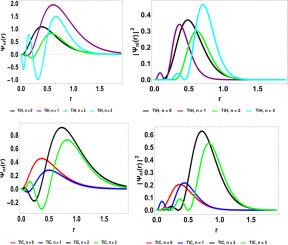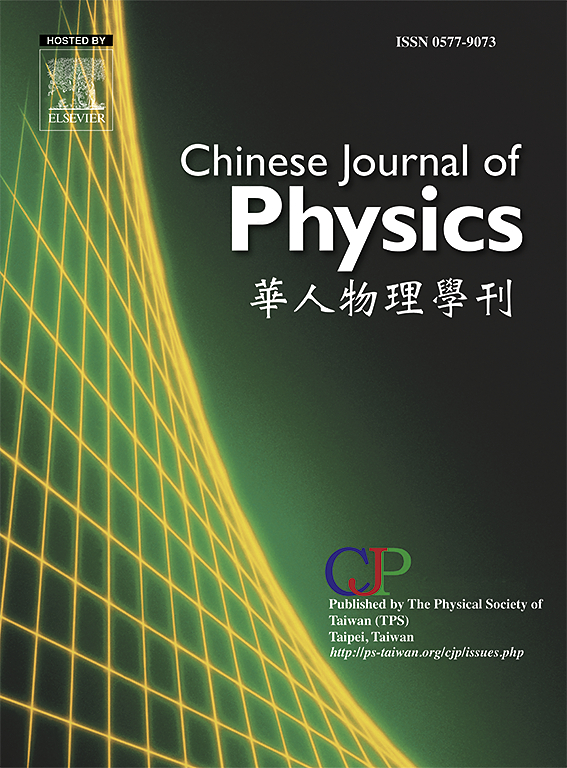Quantum mechanical analysis of cesium dimer, titanium hydride, and titanium carbide: Vibrational spectra, expectation values, and information-theoretic measures
IF 4.6
2区 物理与天体物理
Q1 PHYSICS, MULTIDISCIPLINARY
引用次数: 0
Abstract
This study explores quantum systems governed by a hybrid potential model that combines the Möbius square and screened Kratzer potentials (MSSKP). The Schrödinger Eq. was solved analytically using the parametric Nikiforov–Uvarov (pNU) method to investigate the quantum properties of heteronuclear diatomic molecules such as titanium hydride (TiH) and titanium carbide (TiC). Information-theoretic measures—namely, Shannon entropy and Fisher information—were employed to probe wavefunction delocalization and electron density localization, respectively. Expectation values were derived using the Hellmann–Feynman theorem. The results indicate that TiC exhibits stronger electron localization and covalent bonding compared to TiH. Moreover, the vibrational energy levels of the cesium dimer (Cs₂) were calculated and showed excellent agreement with experimental Rydberg–Klein–Rees (RKR) data. Comparative analysis revealed that the MSSKP outperforms the Morse and Manning–Rosen potentials, achieving a minimum mean absolute error (MAE) of 0.0234 cm⁻¹, compared to 0.2364 cm⁻¹ and 0.0517 cm⁻¹, respectively. This work underscores the synergy between quantum mechanical modeling and information theory, offering deeper insights into molecular structure, bonding, and quantum behavior relevant to quantum chemistry and nanophysics.

铯二聚体、氢化钛和碳化钛的量子力学分析:振动谱、期望值和信息理论测量
本研究探索了由结合Möbius平方和筛选克拉泽势(MSSKP)的混合势模型控制的量子系统。采用参数化Nikiforov-Uvarov (pNU)方法解析求解Schrödinger方程,研究了氢化钛(TiH)和碳化钛(TiC)等异核双原子分子的量子性质。利用信息理论度量,即Shannon熵和Fisher信息分别探测波函数离域和电子密度局域。期望值是用赫尔曼-费曼定理推导出来的。结果表明,与TiH相比,TiC具有更强的电子定位和共价键。计算了铯二聚体(Cs₂)的振动能级,与实验Rydberg-Klein-Rees (RKR)数据吻合良好。对比分析显示,MSSKP比莫尔斯电位和曼宁-罗森电位更有效,最小平均绝对误差(MAE)为0.0234 cm⁻¹,而前者为0.2364 cm⁻¹,后者为0.0517 cm⁻¹。这项工作强调了量子力学建模和信息理论之间的协同作用,为与量子化学和纳米物理相关的分子结构、键和量子行为提供了更深入的见解。
本文章由计算机程序翻译,如有差异,请以英文原文为准。
求助全文
约1分钟内获得全文
求助全文
来源期刊

Chinese Journal of Physics
物理-物理:综合
CiteScore
8.50
自引率
10.00%
发文量
361
审稿时长
44 days
期刊介绍:
The Chinese Journal of Physics publishes important advances in various branches in physics, including statistical and biophysical physics, condensed matter physics, atomic/molecular physics, optics, particle physics and nuclear physics.
The editors welcome manuscripts on:
-General Physics: Statistical and Quantum Mechanics, etc.-
Gravitation and Astrophysics-
Elementary Particles and Fields-
Nuclear Physics-
Atomic, Molecular, and Optical Physics-
Quantum Information and Quantum Computation-
Fluid Dynamics, Nonlinear Dynamics, Chaos, and Complex Networks-
Plasma and Beam Physics-
Condensed Matter: Structure, etc.-
Condensed Matter: Electronic Properties, etc.-
Polymer, Soft Matter, Biological, and Interdisciplinary Physics.
CJP publishes regular research papers, feature articles and review papers.
 求助内容:
求助内容: 应助结果提醒方式:
应助结果提醒方式:


